
home | 1900 | 1925 | 1930 | 1937 | 1941 | 1945 | 1946 | 1949 | 1952 | 1956 | 1960 | 1969 | 1978 | greenwich | info

"Fag" card collection - see below
According to history, it was on the 4th October 1930 when the Airship R101 flew over London on its way to India. I remember watching it outside our flat on a dull Saturday evening. It crashed in France during a storm the following morning.
Fred and I started school at Franciscan Road Infants and Junior Schools and later progressed to Selincourt Road School. My particular memories of Franciscan Road were the woodworking classes, which I enjoyed. I was also commended for my spelling which was probably the only subject that I was any good at! I do remember playing football as a school activity on Tooting Bec Common. It was on a cinder pitch and I got a few grazed knees from falling over there. We had our swimming lessons at Balham Baths and the only thing I remember was that someone pushed me in the water; consequently I became scared of the water and didn't learn to swim at school.
Aunt May, uncle Harry (Flood) and their daughter Gladys lived next door to us at No. 56 Glasford Street. Uncle Harry was a shoe repairer and he had a shop at Eardley Road, Streatham. He also sold bicycle parts and accessories. Cousin Gladys was a few years older than me and also attended Franciscan Road School.
The houses in Glasford Street were terraced with no front gardens, but a small area just wide enough to park a pram separated the house from a brick coping wall surmounted with iron railings. The front doors were in pairs, one for the upstairs flat and the other for downstairs; both flats 56 and 58 were downstairs. There were no bathrooms and the toilet was situated in the back garden, next to the coal shed. A large galvanised bathtub hung on the outside wall of the coal shed; this was brought indoors on bath nights, placed on the living room floor and filled with hot water from the kitchen.
The back gardens were small but adequate; a few loose planks of wood in the fence allowed us access to aunt May's garden and flat next door.
Dad had a Wireless Set which required an accumulator to operate it, this being before we had electricity installed. So it was my job every Saturday to take the accumulator to be recharged at a shop in Selincourt Road.
Our dad seemed to become more ill after we moved to Tooting. Although
we weren't old enough to understand at the time, he was suffering from
an incurable chest complaint and seemed to spend more time away in hospital
and convalescent homes than at home with us children. I do remember he
was staying at a convalescent home at Worthing in 1931 or 1932 when mum
took us down there to visit him. I have some good photos of our happy
family group which we took at the time.
Mike says: but unfortunately, I don't have
those pictures...
Dad died at our home at 58 Glasford Street, Tooting on 30th January 1933, aged 40 years and 2 months. He was buried at Streatham Cemetery, Garratt Lane, Tooting.
Mike says: My dad was 11½ when his father died; his brothers obviously younger.
We continued to live at Glasford Street for a few more years, during which time electric lighting was installed at the flat, for up to then we had only had gas lighting.
Mum was obviously finding it hard to manage with three boys to bring-up alone, so she found a lodger to live in the front room. Fred and I were also given domestic chores to do in the home and run errands to the nearby shops at Tooting Junction. Our leisure time was mostly spent playing in the streets nearby, there being very few cars about in those days; so it was a common sight to see a game of football in the street, or cricket using a lamp post as the wicket. Other street games included "marbles"; "whip & top"; "rolling a hoop"; "hula-hoop"; "diablo"; "yo-yo"; "ball-up-the-wall"; "roller skating" and cycling around the block.

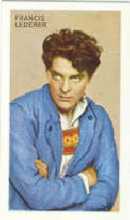
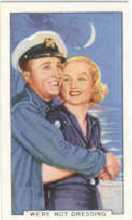
Collecting "fag" cards was probably my very first hobby; these
were small picture cards, which were found in most cigarette packets
and were very collectable by small boys in particular. The front face
of the card displayed a colour picture of a film star, sports personality
or maybe royalty; other subjects included flags, aeroplanes, ships, cars
and steam locomotives.
Mike says: Oh how the colloquialisms have changed! "Fag" cards indeed…
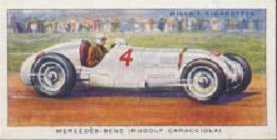
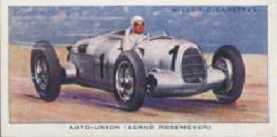
On the back of the card was a good description of the subject. The aim
was to collect a full set of the cards in good condition, which would
eventually prove to be valuable.
The discovery of a discarded empty cigarette packet in a waste paper bin or laying in the street would often reveal a brand new card in good condition, much to the delight of the finder.
Odd cards were used for swapping and for playing the game of "flicks". The aim of this game was to flick your card towards your opponent's card, which was propped up against the wall, it had to knock it down and cover it at least half way; the winner then claimed both cards to add to his collection.
An annual event that we looked forward to was Mitcham Fair held on Mitcham Common, about half an hour's walk from home. We saved up our pocket money all the year round to go there, and one year I managed to save half a crown (2/6d, £0.125, €0.19).
As Mars Bars were a 1d each our local sweet shop obliged by cutting them in half for the school kids for ½d, but when they started selling Milky Ways we bought them instead, still only ½d.
I remember going to see a Variety Show once at Balham Hippodrome, probably with mum and dad. Flanagan and Allen were performing, also Nellie Wallace. I may have gone to see other shows there although I can't remember, but that one stuck in my mind.
There were several "Picture Houses" in Tooting in our early days there, showing silent movies, usually with a pianist to accompany the film. Buster Keaton, Harold Lloyd and Charlie Chaplin were the favourites. Saturday morning cowboy films were shown at the Broadway Cinema and Tom Mix, Buck Rogers and Hop-a-long Cassidy were worth queuing up for.
I saw my first "Talkie" on a mobile screen outside Central Hall in Longmead Road, Tooting Broadway, but it didn't take long after that for all the cinemas to convert to showing films with sound, although still in black and white, of course. Soon, more cinemas were built or old ones converted; most of the older ones were quite small inside, but I clearly remember two enormous new cinemas being built in Tooting. One was the Mayfair in Upper Tooting, which had a stage and a giant organ, the other was the Granada in Mitcham Road, Tooting Broadway. This was in the main shopping centre and it caused a lot of excitement locally, especially amongst the children.
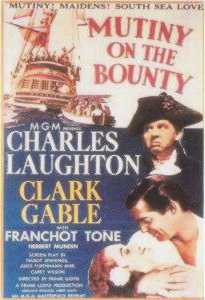
The Saturday morning shows and Children's Club attracted kids from miles
around and the queues formed outside the cinema were enormous. One of
the big attractions at the Granada was the organ, known as the "Mighty
Wurlitzer"; its first and most famous organist was Harold Ramsey.
There was also a regular orchestra that played either in the orchestra
pit or on the very large stage: in those days it was common to have a
stage show or organ recital in the interval of the film shows. As a rule,
the whole show consisted of a main feature film, plus a second film,
a cartoon film, a newsreel, trailers and advertisements. I remember seeing
the original version of "Mutiny on the Bounty" with Charles Laughton
at the Granada Cinema. By time we left Tooting in about 1937 there were
nine Cinemas there.
When I was about twelve years old I went into Great Ormond Street Children's Hospital in London to have my tonsils and adenoids removed. I remember this occasion very well. I only stayed in hospital for one night, then mum came to fetch me the following day and took me home to Tooting by tram. We visited a cousin of hers at Holborn on the way home. Shortly after this I went to a convalescent home at Weston-Super-Mare for several weeks, which was my very first long stay away from home.
Our Uncle Max, Aunt Nell's second husband, died whilst I was away at Weston-Super-Mare. He was a retired Chiropodist and Aunt Nell and Uncle Max had lived at Mitcham Lane, Streatham, with our cousin Win and her husband Laurie.
Continues on page two

This work is licensed under a Creative Commons Attribution-Noncommercial-No Derivative Works 2.0 UK: England & Wales License.
Text by Alf Allen 1999. Edited and spell-checked by Mike Allen 2003.
Most photos taken by Alf and most illustrations drawn by him; scanned from
his albums, etc., now in my possession and digitally edited 2003-2005.
Yes, yes, the photos and layout need updating - the website was first designed in "dial-up days", before any sort of broadband, and everything had to be small so it uploaded and downloaded fast. Work to do, I know.
Website produced 2003-2013 by Mike Allen - a fatuous platitudes production.
Last changed 28-Aug-2013 22:54